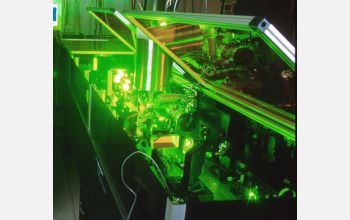Multimedia Gallery
A state-of-the-art femtosecond laser amplifier system
A state-of-the-art femtosecond laser amplifier system. Although the pulse energies from this laser are modest (on the order of millijoules) and the size relatively small, the laser system crams all of the energy into a tiny 20-femtosecond pulse. The result is a peak power close to a terawatt -- roughly the continuous electrical generating capacity of the United States. The amplifier system allows researchers to generate coherent EUV (extreme-ultraviolet wavelength) beams by focusing the laser into a hollow fiber called a waveguide. The green light in the picture comes from the pump lasers that are used to amplify the femtosecond pulses to the terawatt level.
More about this Image
A National Science Foundation-supported research team from the University of Colorado's Joint Institute for Laboratory Astrophysics (JILA) have created an extreme-ultraviolet, laser-like beam capable of producing tightly focused light in a region of the electromagnetic spectrum not previously accessible to scientists. The process combines concepts from electromagnetic radiation research and fiber optics.
EUV wavelengths -- between one and 100 times shorter than visible light waves -- allow researchers to see tiny features and carve miniature patterns with applications in such fields as microscopy, lithography and nanotechnology.
The achievement is based on a new structure called a "waveguide," a hollow glass tube with internal humps that coax light waves into traveling along at the same speed and help the waves reinforce each other.
These findings were reported in the Jan. 2, 2003, issue of the journal Nature. The research was principally supported by NSF, with additional funds from the Department of Energy. For further information about the research, see NSF Press Release 03-01. (Year of image: 2002)
Credit: Courtesy University of Colorado; National Science Foundation
Images and other media in the National Science Foundation Multimedia Gallery are available for use in print and electronic material by NSF employees, members of the media, university staff, teachers and the general public. All media in the gallery are intended for personal, educational and nonprofit/non-commercial use only.
Images credited to the National Science Foundation, a federal agency, are in the public domain. The images were created by employees of the United States Government as part of their official duties or prepared by contractors as "works for hire" for NSF. You may freely use NSF-credited images and, at your discretion, credit NSF with a "Courtesy: National Science Foundation" notation.
Additional information about general usage can be found in Conditions.
Also Available:
Download the high-resolution JPG version of the image. (1.3 MB)
Use your mouse to right-click (Mac users may need to Ctrl-click) the link above and choose the option that will save the file or target to your computer.



 All images in this series
All images in this series